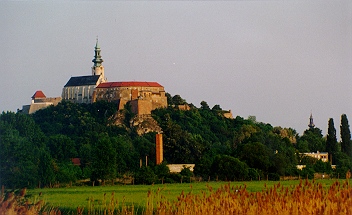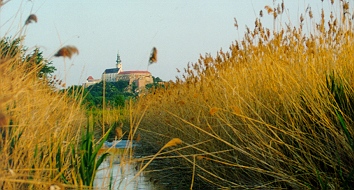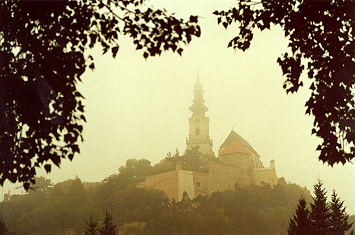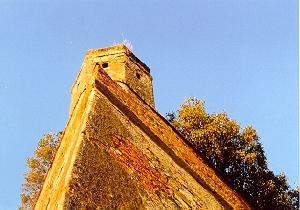
A part of the castle baroque fortification with characteristic bastion
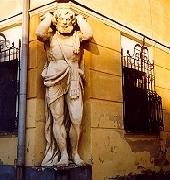
Corgo˛ supported a corner
of Kluch┤s palace
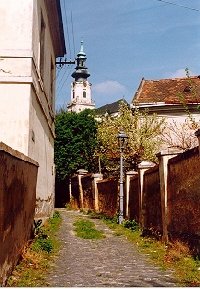
A view of church cathedral spire from an old road in Upper town
|
Nitra castle is the most precious heritage left to Nitra by its ancestors and dominates the panorama of the city. Since 1981 the castle has been ranked National Cultural Monument. It is situated on a small hill above the level of the city and unlike most of Slovak castles is still fully functional. In the Bishop┤s Palace is the office and the residence of the bishop and serves as a seat of archeological department too. /Photo - A view of the castle from Svatopluk┤s square in the city centre./
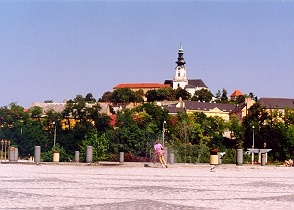
During its existence the castle was several times strongly damaged and consecutively rebuilt and its current appearance has acquired in 17th century. The whole castle complex consists of the castle itself and primarily baroque styled buildings in so-called Upper town. The oldest preserved part is Romanesque church of St. Emmeram dating back to 11th century, however the castle hill was settled even earlier. After massive damages to the castle, caused by Matus Cak of Trencin, was built new Upper church finished as late as in 1355. This Cathedral was completed by bishop Jan Telegdy who built in 1621 - 1642 Lower church and these three churches are interconnected.
Next to the Cathedral is two-floor Bishop┤s palace which was found in the Middle Ages and rebuilt in 18th century. The Palace is the office and the residence of the bishop.
The castle is fortificated by massive walls, which also underwent a number of reconstructions. The first walls seem to have been done during the period of Great Moravia /see History/ and later several times reconstructed. An extensive works were carried out from 15th to 17th century owing to development and use of fire-arms and defensive system was modified. Also the castle was damaged several times during anti-Turks wars and revolts. Present appearance has been obtained in 17th century after the Turks were expelled from Nitra in 1664 and star-shaped baroque fortification with bastions was built. There is one south-oriented entrance gate in the castle.
In 18th century a boom in building occured and several baroque buildings were built which are up to this day precious architectural monuments.
1710 - 1736 - At the request of bishop Erd÷dy the whole interior of the castle Cathedral was rebuilt under the leadership of Italian architect Domenico Martinelli.
1750 - Plague column erected next to the castle entrance gate to put in remembrance devastating epidemic in 1739 when a fourth of inhabitants died. The column was created by Martin Vogerle and the same one stands in Austrian town Hainburg.
1764 - 1770 - In Upper town monumental the Big Seminary constructed and in 1779  completed west wing. Later in 1877 Diocese Library opened in northwest wing. It contains more than 65 000 volumes and 74 incunabilia that is first-printings from 1473 - 1500. The Library represents one of the most valuable monuments of Slovakia and even of Europe and ranks completed west wing. Later in 1877 Diocese Library opened in northwest wing. It contains more than 65 000 volumes and 74 incunabilia that is first-printings from 1473 - 1500. The Library represents one of the most valuable monuments of Slovakia and even of Europe and ranks
1820 - Bishop Kluch ordered to build so-called Kluch┤s palace. One of the corners is supported by Atlas, in Nitra called Corgon. This statue was created by Slovak sculptor Vavrinec Dunajsky.
1884 - Opposite the Big Seminary across the square built the Little Seminary according to design of Karel Mayer.
|




